In the context of increasing attention to air quality, especially in enclosed spaces where air circulation is limited, UV Lamp Air Sterilizer (ultraviolet air sterilizer) has become a widely used device to improve air hygiene. However, many users still have confusion about its actual performance, applicable scope, and proper operation. The following will address these practical questions by combining industry expertise and real application scenarios.
1. Core Mechanism: What makes UV Lamp Air Sterilizer effective in purifying air? Does it produce harmful substances during operation?
The core of UV Lamp Air Sterilizer lies in the use of UVC ultraviolet rays (with a wavelength range of 200-280nm) to inactivate airborne microorganisms. Unlike some air purifiers that rely on filters to trap particles, this device works by drawing contaminated air into its internal sterilization chamber through a fan. Once inside, the UVC rays directly act on bacteria, viruses, mold spores, and other pathogens in the air. By breaking the hydrogen bonds in their DNA or RNA molecules, the rays disrupt the genetic material of these microorganisms, making them unable to replicate or infect, thus achieving the goal of air sterilization.
A common concern among users is whether the device generates harmful by-products during operation. Under normal circumstances, if the UV Lamp Air Sterilizer uses a standard low-pressure mercury lamp and is properly sealed (to prevent UV leakage), it will not produce toxic substances like formaldehyde or benzene. However, it should be noted that some devices may generate a small amount of ozone when the UV rays irradiate oxygen in the air. While low-concentration ozone can assist in disinfection, excessive ozone (exceeding the national standard of 0.1mg/m³) can irritate the human respiratory tract and cause discomfort. Therefore, when purchasing, it is advisable to choose models labeled "low-ozone" or "ozone-free," especially for indoor spaces with long-term human occupancy, such as bedrooms and offices.
2. Application Scope: In which enclosed spaces can UV Lamp Air Sterilizer play its best role? Are there any environments where it is not suitable?
UV Lamp Air Sterilizer is highly suitable for enclosed or semi-enclosed spaces with high requirements for air hygiene and relatively poor natural ventilation. In medical settings, it is widely used in hospital consulting rooms, isolation wards, and operating rooms to reduce the spread of airborne pathogens and protect the health of medical staff and patients. In public places, it is an ideal choice for classrooms, libraries, and office meeting rooms—spaces where people gather, and the risk of cross-infection through air is high. In households, it can be placed in bedrooms, nurseries, and bathrooms to eliminate mold spores and bacteria that cause odors, creating a healthier living environment.
However, there are also environments where UV Lamp Air Sterilizer is not suitable or requires special attention. First, it should not be used in open-air or highly ventilated spaces. In such environments, the sterilized air will quickly mix with unsterilized outdoor air, significantly reducing the device's effectiveness. Second, it is not recommended for use in spaces with high concentrations of dust or oil fumes, such as kitchen exhaust areas or construction sites. Excessive dust and oil droplets can adhere to the surface of the UV lamp, blocking the emission of ultraviolet rays and shortening the lamp's service life. Additionally, for spaces with pets that have sensitive respiratory systems (such as birds or small mammals), it is necessary to select ozone-free models and avoid direct irradiation of the pets, as UV rays and ozone may cause discomfort to them.
Enterprises like Jiangyin Jianshifu Equipment Co., Ltd., which have rich experience in the disinfection equipment industry, not only produce UV water and trolley sterilizers but also offer UV Lamp Air Sterilizers tailored to different space sizes. They can provide targeted recommendations based on factors such as the area of the space, the number of occupants, and air quality requirements, ensuring that the device meets the actual needs of users.
3. Selection Guidelines: What factors should be considered when choosing a UV Lamp Air Sterilizer for different space sizes? How to avoid buying an ineffective product?
Choosing the right UV Lamp Air Sterilizer requires matching the device's performance to the specific characteristics of the space. The first key factor is the air exchange rate (usually expressed as times per hour). This refers to how many times the device can filter and sterilize the total volume of air in the space within one hour. For general indoor spaces (such as bedrooms and offices), an air exchange rate of 4-6 times per hour is sufficient to maintain good air quality. For high-risk areas like hospital wards, a rate of 8-10 times per hour or higher is required. When calculating, multiply the space's area (in square meters) by its height (in meters) to get the volume, then select a device whose air handling capacity (in cubic meters per hour) can achieve the required exchange rate. For example, a 20-square-meter bedroom with a height of 2.8 meters has a volume of 56 cubic meters; a device with an air handling capacity of 224-336 cubic meters per hour (56×4 to 56×6) is suitable.
The second factor is the type and power of the UV lamp. There are two main types of UV lamps used in air sterilizers: low-pressure mercury lamps and amalgam lamps. Low-pressure mercury lamps are cost-effective and have a long service life (usually 8,000-12,000 hours), making them suitable for home and small office use. Amalgam lamps, on the other hand, have higher UV intensity and can withstand higher temperatures, making them more suitable for large spaces like shopping malls or factory workshops. The power of the lamp also matters—higher power generally means stronger sterilization ability, but it also consumes more energy. For small spaces (less than 30 square meters), a 15-30W UV lamp is sufficient; for medium to large spaces (30-100 square meters), a 30-60W lamp is needed.
To avoid buying an ineffective product, it is essential to check the product's certification and test reports. Qualified UV Lamp Air Sterilizers should have a "Disinfection Product Sanitary Safety Evaluation Report" issued by the relevant national authorities, which clearly states the device's sterilization rate (for common pathogens like Escherichia coli and Staphylococcus aureus, the rate should be ≥99%) and ozone emission concentration. Additionally, it is advisable to choose products from manufacturers with a good reputation and complete after-sales service, such as Jiangyin Jianshifu Equipment Co., Ltd. These manufacturers usually provide detailed product specifications and professional consultation services, helping users avoid buying products that are either over-configured or underperforming.
4. Operation Tips: Is it safe to use UV Lamp Air Sterilizer when people are present? What mistakes should be avoided during daily use?
The safety of using UV Lamp Air Sterilizer when people are present is a top concern for users. In general, it is not recommended to use ordinary UV Lamp Air Sterilizers in occupied spaces. Direct exposure to UVC rays can cause damage to human skin and eyes—short-term exposure may lead to skin redness, itching, and eye irritation (such as tearing and photophobia), while long-term or high-intensity exposure can increase the risk of skin aging and cataracts. However, some advanced models on the market are equipped with a "human body induction function": when the sensor detects that someone enters the space, the UV lamp will automatically turn off or reduce its intensity, allowing for safe use when people are present. If users need to sterilize occupied spaces (such as classrooms during class breaks), they should prioritize choosing such models and confirm the sensitivity and reliability of the induction function before purchase.
During daily use, there are several common mistakes to avoid. First, do not place the device in a corner or block its air inlet/outlet with objects (such as curtains or furniture). This will hinder air circulation, reducing the device's ability to draw in contaminated air and discharge sterilized air. Second, do not rely solely on the UV Lamp Air Sterilizer to solve all air quality problems. The device mainly targets microorganisms; it cannot remove particulate matter (such as PM2.5) or volatile organic compounds (VOCs) from the air. Therefore, it should be used in conjunction with other air purification devices (such as HEPA filter purifiers) if necessary. Third, do not ignore the impact of environmental humidity. High humidity (above 80%) can reduce the effectiveness of UV sterilization, as water vapor may absorb part of the UV rays. In humid environments (such as bathrooms), it is recommended to use a dehumidifier together with the UV air sterilizer.
5. Maintenance and Troubleshooting: How to extend the service life of a UV Lamp Air Sterilizer? What should users do if the device's sterilization effect decreases?
Proper maintenance is key to extending the service life of a UV Lamp Air Sterilizer and ensuring its stable performance. The most important maintenance task is cleaning the device regularly. First, turn off the power and unplug the device. Use a dry, soft cloth to wipe the surface of the device to remove dust. Then, remove the air filter (if the device is equipped with one) and clean it—for washable filters, rinse them with clean water and dry them thoroughly before reinstalling; for non-washable filters, replace them according to the manufacturer's recommendations (usually every 3-6 months). Next, check the surface of the UV lamp for dust or oil stains; if there are any, gently wipe it with a cotton swab dipped in 75% alcohol (do not use water or other corrosive cleaning agents, as they may damage the lamp).
Another crucial maintenance step is replacing the UV lamp on time. Even if the lamp still emits light, its UV intensity will gradually decrease over time. When the intensity drops to 70% of the initial value (usually after 8,000-12,000 hours of use for low-pressure mercury lamps), the sterilization effect will be significantly reduced, and the lamp should be replaced immediately. Users can check the lamp's usage time through the device's display screen (if available) or set a reminder based on the manufacturer's recommended replacement cycle. When replacing the lamp, ensure that the new lamp has the same model and specifications as the original one to avoid compatibility issues.
If users notice a decrease in the device's sterilization effect (for example, the space still has a musty smell after long-term use, or family members frequently catch colds), they can troubleshoot from the following aspects. First, check if the UV lamp needs to be replaced—if the lamp has been used for more than the recommended service life, replacing it may solve the problem. Second, inspect the air filter—if it is severely clogged with dust, it will reduce air flow, affecting the device's ability to contact air with UV rays. Third, check the fan—if the fan makes abnormal noises or rotates at a reduced speed, it may be faulty, leading to poor air circulation. In such cases, do not disassemble the device by yourself; contact the manufacturer's after-sales service for repairs. For example, Jiangyin Jianshifu Equipment Co., Ltd. provides remote technical support and on-site maintenance services for its products, helping users quickly resolve issues and restore the device's performance.
In addition, it is recommended to conduct a "performance test" on the device every 6-12 months. This can be done by using a professional UV intensity detector to measure the lamp's intensity or by referring to the device's self-test function (if available). Regular testing ensures that the device is always in good working condition and provides reliable air sterilization.


 English
English  عربى
عربى 
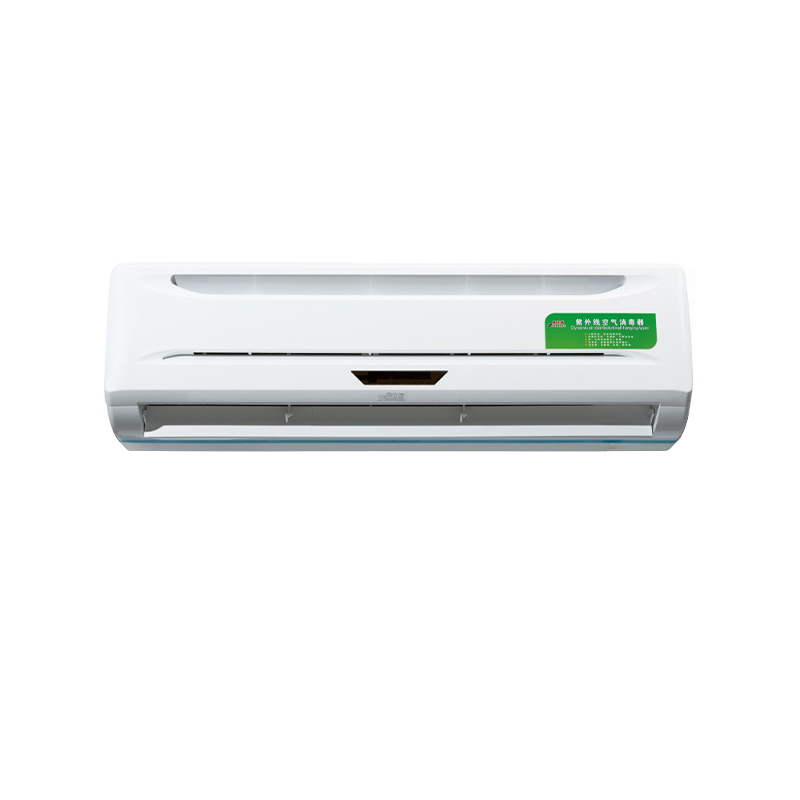
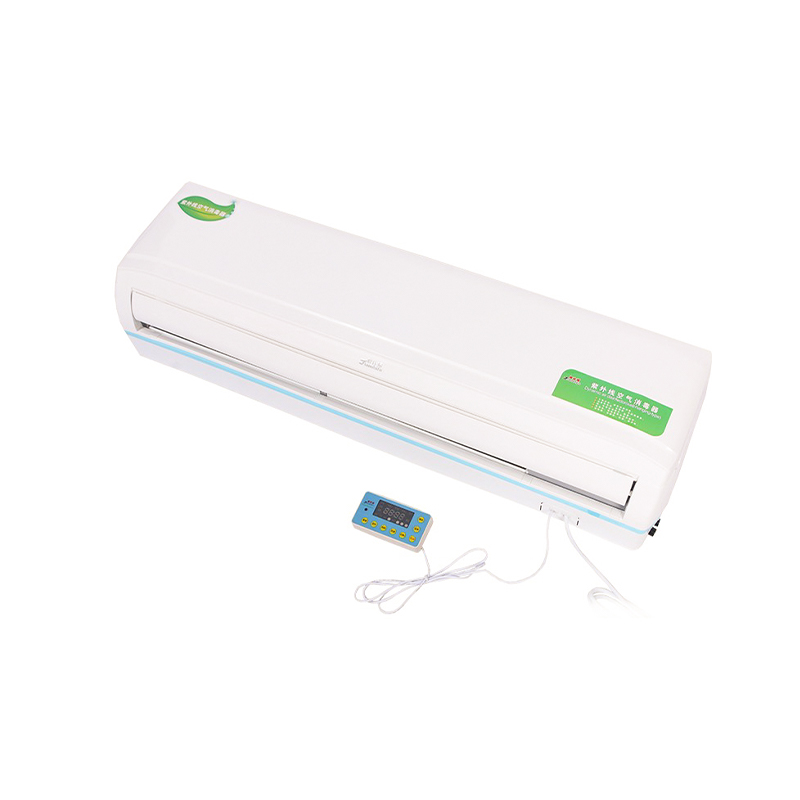
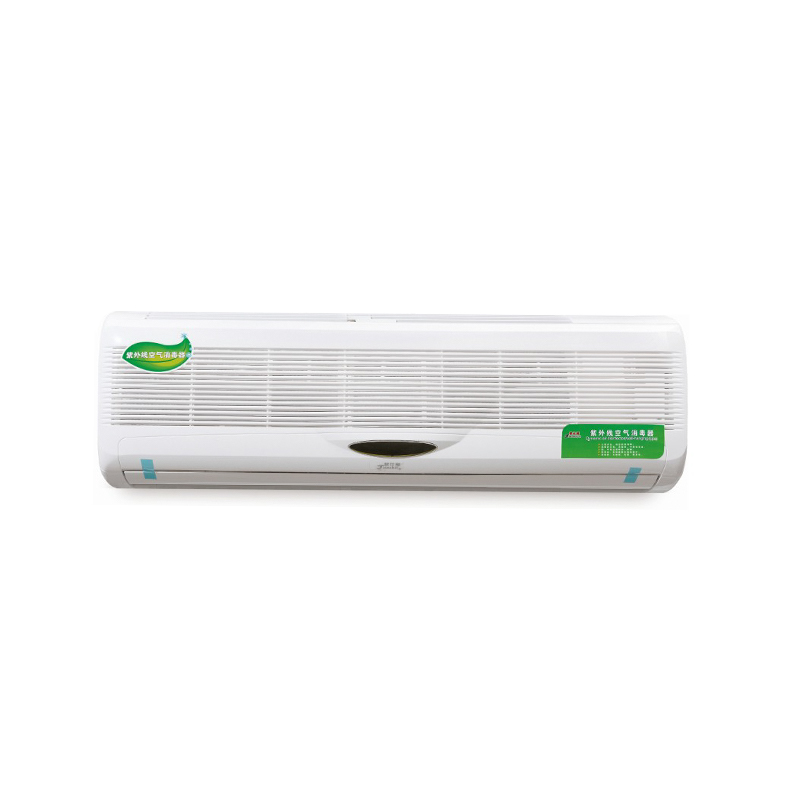
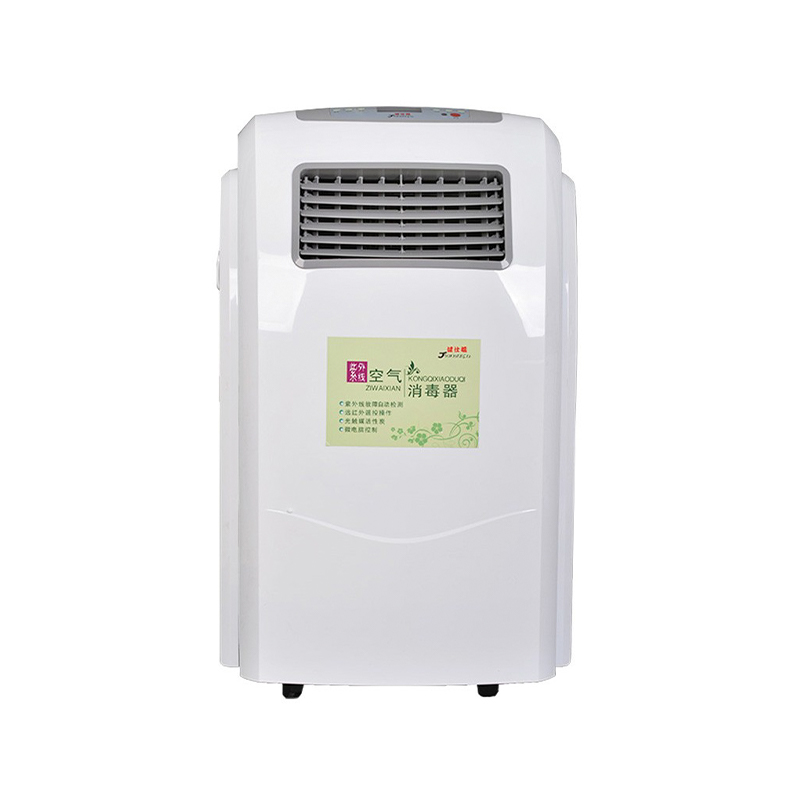

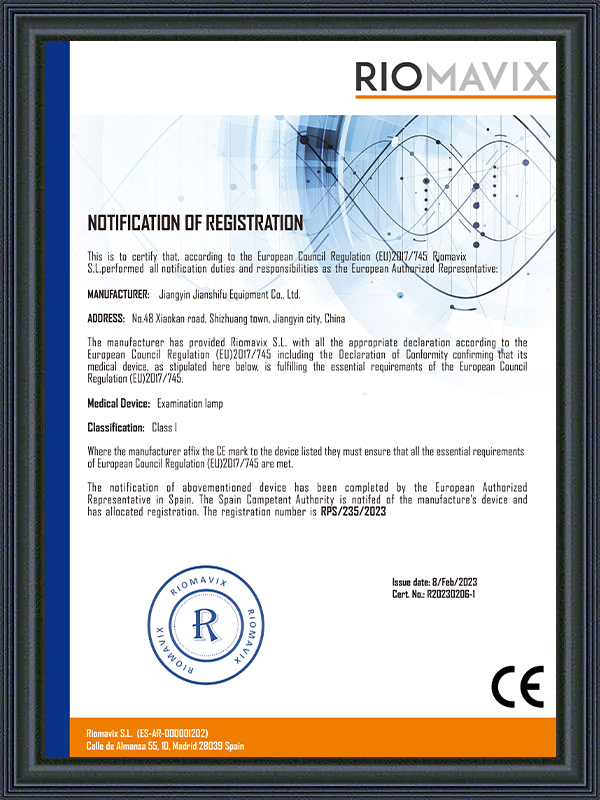
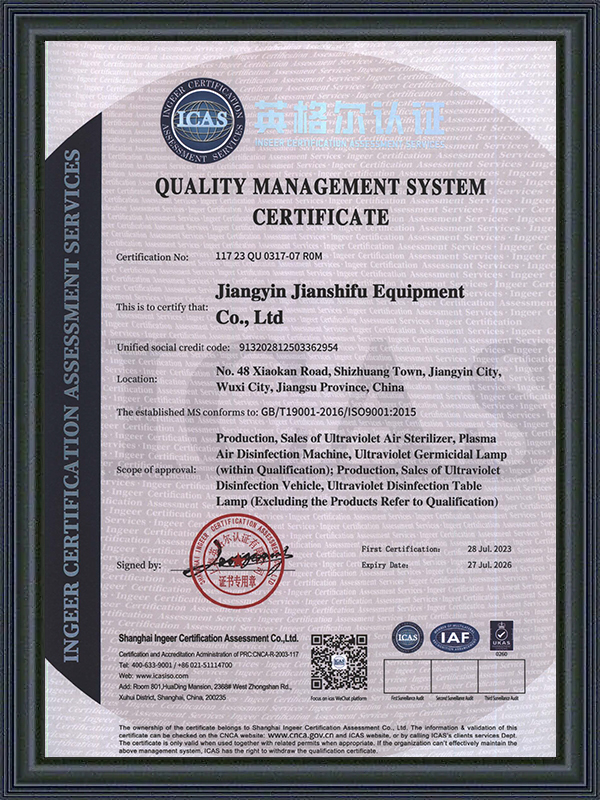
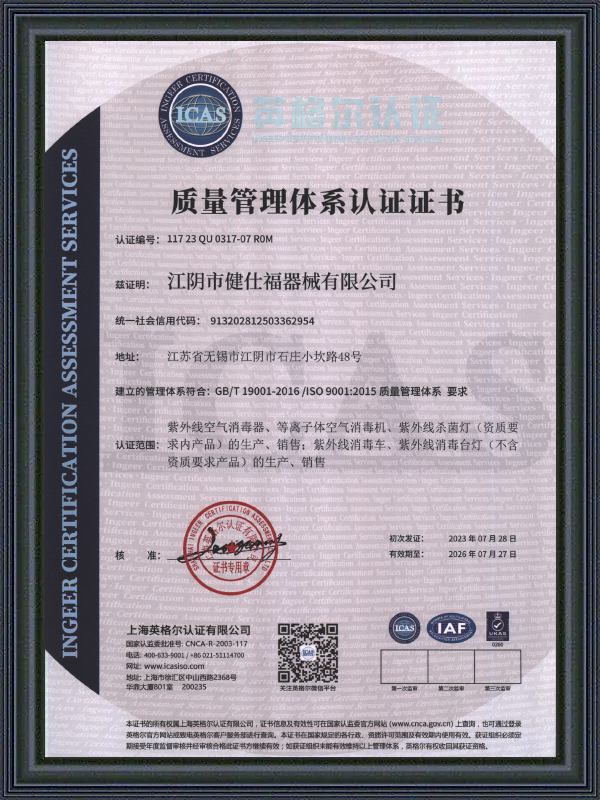
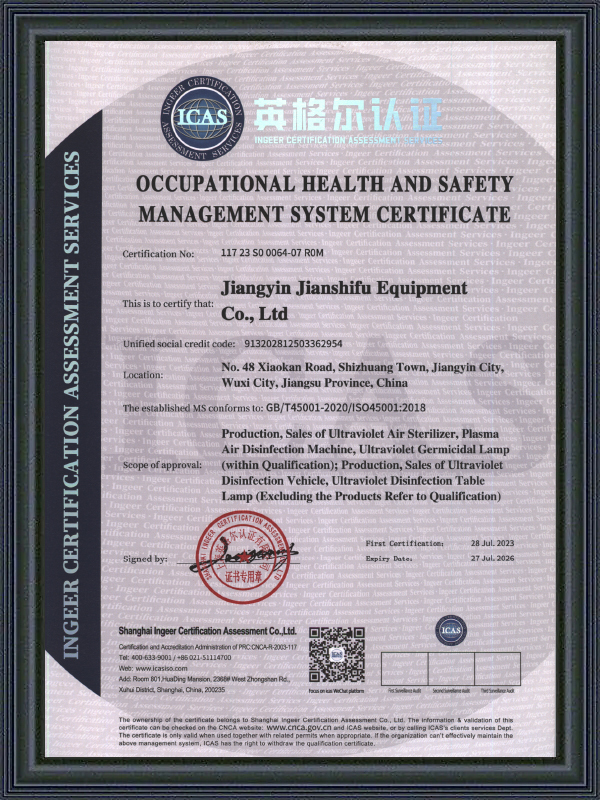
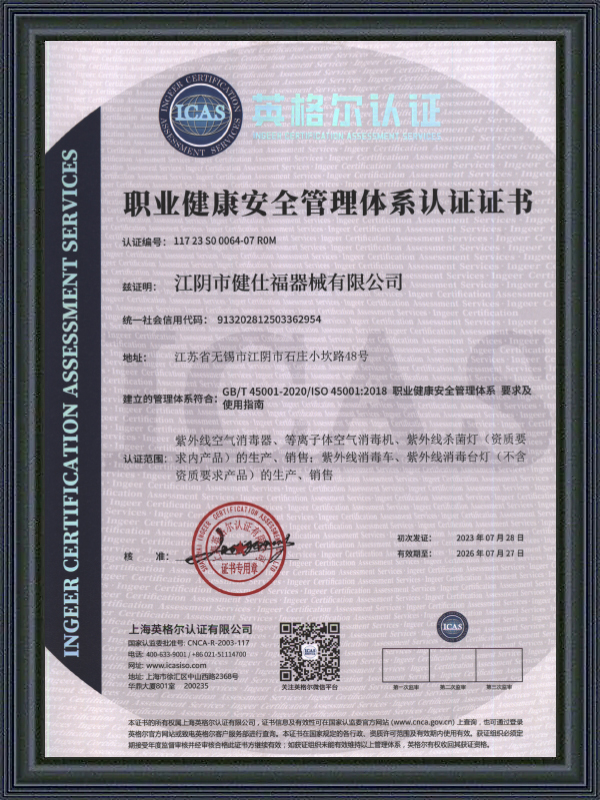
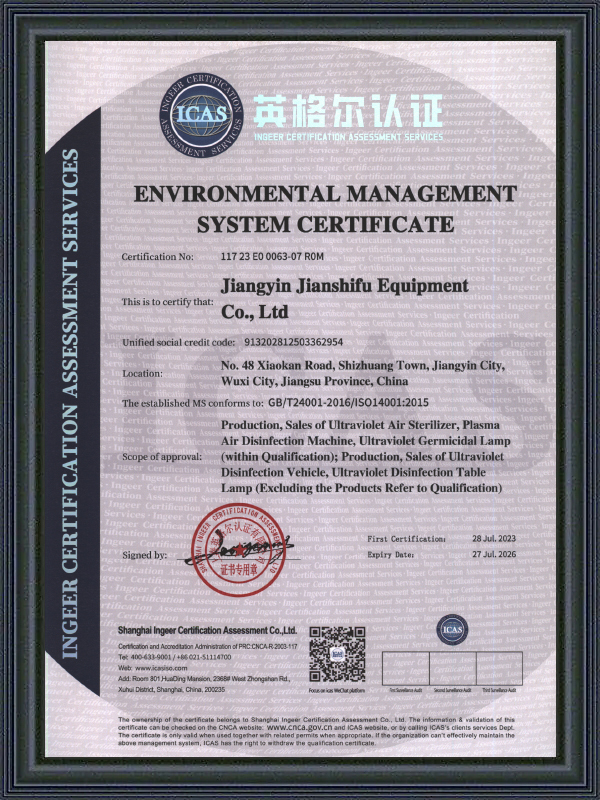
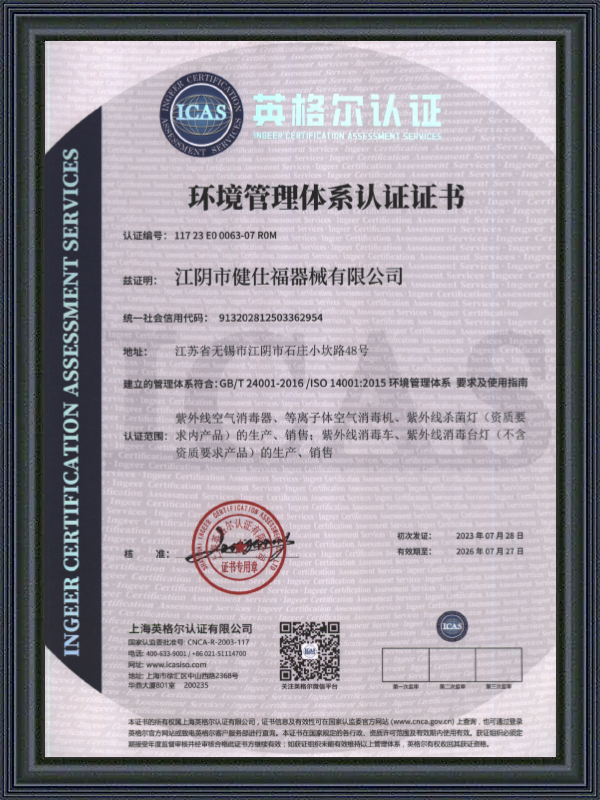

 No 48 Xiaokan Rd, Shizhuang town, Jiangyin, Jiangsu, China
No 48 Xiaokan Rd, Shizhuang town, Jiangyin, Jiangsu, China sara@jsf-qx.com
sara@jsf-qx.com +86-18915253915
+86-18915253915 +86-18861287595
+86-18861287595